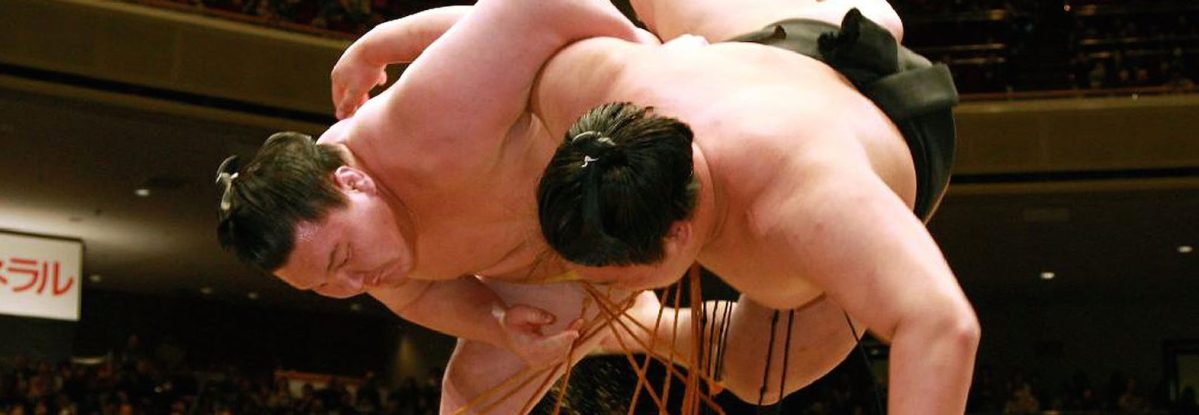“Weight is highly overrated in sumo,” said Andrew Freund, founder of the US Sumo Open tournament. (Started in 2001, it continues today as the largest, longest-running sumo tournament outside Japan, drawing thousands to see male and female competitors from around the world in various weight classes—champs range from massive Japanese men to relatively petite Swedish women.) Many who haven’t experienced sumo have an image of, to put it bluntly, fat guys in diapers moving “like big balloons, just bouncing around.” Freund noted this perception hasn’t been helped by “those stupid party sumo suits.”
What’s sumo really about? “Flexibility and speed.” Traditionally, on the pro level, it’s also about desperation: those who embrace it tend to have few better options. They turn to a pursuit where for years you devote your entire life to attempting to master a frequently brutal activity. You only take control again if you somehow are one of the few who gradually rise to the top or you wash out.
Indeed, there is something about sumo that encourages obsession, on the amateur side too. Look at Freund. He first encountered sumo while teaching in Japan in the ’90s. Back in L.A., he wound up trying sumo at an exhibition. (He did it only to convince a much larger friend to give it a shot as well: “At the time I was about 141, 142 pounds. Now I’m up in the 150s after 20 years of training.”)
Soon Freund had started a sumo club at UCLA. Then came the Open: “I basically lost everything I had. I had liens on cars, bank loans. Every penny I made from teaching went into that. I went, ‘Never again.’ Somehow I did it again.”
Beyond the Open, today he and sumo wrestlers engage in “live events, exhibitions, corporate parties, TV shows, films, commercials, and on and on.” These include the wrestler Yama, who is the “heaviest Japanese human being in recorded history.” (You can book Yama and his colleagues here. See more of both Yama and Andrew in the video below.)
“I’m doing sumo stuff 80 or 90, sometimes 100 hours a week,” Freund said. It remains a labor of love: “We’re at McDonald’s level wages.”
Yet for full fixation, it’s necessary to head to Japan and experience the pro version. Incredibly, this uniquely Japanese activity has been largely taken over by outsiders, with one Mongolian in particular casting an unmatched shadow.
Less a Sport Than Your Life
“Even in Japan, it’s not really like any other sport,” Freund said. “All sports I know of have off-seasons and people have private lives.” With six tournaments lasting 15 days spread throughout the year, essentially wrestlers finish one and immediately begin preparing for the next. And they prepare like they do everything else: together.
It’s an existence unique in pro sports: “Until you get to the very high ranks, you’re all living in the same building, sleeping in the same room, eating the same cooking—training, cleaning, shopping, doing everything together.”
Truly, there’s nothing like it: “If you were on a pro basketball team, you wouldn’t have the players all shop for food.”
And no matter how talented you are, you will be humbled: “You start at the bottom of the totem pole. You’re the one who’s cooking the meals. You don’t get to eat until the end. You’re serving everybody else. You have to work your way up.”
This is true even if you immediately display unprecedented talent: “Even if you won every match, it would take at least two or three years to get to the top two divisions.”
Indeed, Freund said in many ways it’s less a sport than a “maintenance of traditional Japanese cultural values.” (Freund noted there are “really only two full-time occupations that have essentially lived the same way for centuries: geishas and sumo wrestlers.”)
Embracing this life is a “very difficult challenge for many non-Japanese.”
Which makes it all the more impressive that in recent years foreigners have consistently risen to the occasion.
The Hunger
Freund said sumo traditionally featured Japanese from “poor farming families.” They knew the life would be difficult, but it seemed to be one of the few paths offering the potential of a better future.
He noted, “Today, if you’re an athletic Japanese kid: ‘I want to go into MMA or play soccer.’”
Indeed, sumo is not a path to guaranteed riches. The very top sumo are called yokozuna. They earn roughly $30,000 a month. Freund said this sum can potentially go significantly higher thanks to sponsors, endorsements, “countless bonuses,” and other revenue streams. But it needs to be remembered there are roughly “700 pro sumo wrestlers” at a given time yet a total of only 72 yokozuna during sumo’s entire history, which is documented back into the 1700s.
The result was Japanese turning away and wrestlers brought in from other places. At first, they were largely Hawaiians, but now Freund said they’re “usually coming from countries that don’t have a very high economic profile.” These include wrestlers from Bulgaria, the Eurasian nation of Georgia, and above all Mongolia.
Ultimately, Japan decided there would only be “one non-Japanese sumo wrestler” in each wrestling stable. That’s why you look at a team and notice “there’s 10 Japanese guys, there’s one Mongolian.” (Stables fluctuate wildly in size, so theoretically there could be a stable with one Japanese wrestler and one foreigner and another stable with 40 Japanese wrestlers and still only one foreigner.)
Why the restriction? Freund said there are two major theories, both of which likely contain some truth. The first is a concern that foreign wrestlers “will do so well they’ll take over the sport.” The second is that “Japanese traditionalists” believe that “foreigners don’t understand the culture to the extent that their Japanese counterparts do.”
Both beliefs are demonstrated by the cases of the Mongolians Asashoryu and Harumafuji. Asashoryu became a yokozuna in 2003 and Harumafuji reached the rank in 2012. Asashoryu was particularly dominant, winning all six tournaments in 2005. They both had their careers abruptly cut short. Each retired in disgrace because of separate allegations of brawling in public, essentially confirming all the traditionalists’ worst fears about turning to foreigners. The video below includes a portion of Asashoryu’s retirement announcement/apology, as well as some displays of his incredible strength. (At just after 90 seconds, his larger opponent is left comically flailing his legs in the air after Asashoryu unexpectedly picks him off the ground.)
Another Mongolian, however, has largely avoided controversies while assembling an unprecedented career.
The Star of Nearly Three Centuries
The hunger sumo requires is in many ways literal. While a weight advantage can be overcome—Freund noted a gifted wrestler weighing roughly 200 pounds once consistently won against a rival weighing 600—if two wrestlers with roughly equal skills meet, the larger man tends to wind up on top. Based on that standard, Hakuho was not a promising prospect. He arrived in Japan at the age of 15 weighing a mere 137 pounds. Just putting on the pounds was a grueling feat. Plus sumo training can be quite savage. Years later, Hakuho recalled beatings that lasted up to 45 minutes: “It becomes easier because even as you’re being beaten up you start to feel less pain.”
Now 32, today Hakuho stands 6’4” and weighs roughly 340 pounds. (This is relatively svelte by top division sumo standards.) Yet Freund said the hunger remains: “He is tremendously consistent in his training. He is incredibly patient in doing all the fundamentals, which are extremely boring.” These include hundreds of leg lifts every day, activities that Freund said are ultimately invaluable: “Little things have kept him relatively injury free.”
The result is a man who has achieved feats that seemed unimaginable. As noted, there is a frightening amount of sumo history. We have the results of nearly every tournament since 1761. We know that in the late 1700s “The Thunderbolt” Raiden Tameemon began winning what reportedly turned out to be a record 28 tournaments. We know this record stood until the 1960s when Taiho emerged and won 32 tournaments. (He was aided by the number of annual tournaments increasing to six in 1958.)
And in turn, this record stood until 2015, when Hakuho won his 33rd championship. But he was not done. He has pushed the record to 40, winning the most recent tournament in November. In 2017 he also became the winner of the most matches in sumo history. He has a record 13 undefeated tournament titles—that means he won each day over a 15-day tournament—and holds the second-longest winning streak in sumo history with 63 straight matches.
Freund has met Hakuho several times and said while he’s an “incredible athlete,” his intelligence is equally important: “From a martial arts perspective, he’s not the heaviest guy. He’s older than a lot of opponents.” Yet he has “tremendous strength and stability in his lower body” and an “incredible sensitivity”: “Whatever the attack that comes at him, he knows how to counterattack.”
This is particularly impressive because sumo matches are often over in seconds—there’s virtually no time between the start and your younger, larger opponent smashing into you. Yet Hakuho continually decides he’s “going to take away his opponent’s attack and then, once he has a better position, he has an easy win.”
Quite simply, Hakuho is dominant in a way even Roger Federer and Jack Nicklaus can’t imagine. Since the beginning of 2007, there have been 65 tournaments (one was canceled).
Hakuho won 39 of them.
“On an objective level, there’s nobody who’s achieved the success that Hakuho has achieved,” Freund said. Considering this is a sport meticulously tracked not just for decades, but for centuries, it’s a uniquely remarkable accomplishment.
In the eyes of many, Hakuho will always have a flaw: he is not Japanese. Accordingly, he has been careful to avoid the offenses committed by the two Mongolian yokozuna: “He realizes and understands that he has to adapt to the Japanese culture… He knows how to speak to the media. He knows how to deal with fans.”
It’s also been Hakuho’s good fortune that Japanese wrestlers have started to rise again, meaning the nation feels better about the sport in general. From 2006 to 2016, a decade passed without a Japanese wrestler taking a title. Now some Japanese are again winning. Indeed, in 2017 Kisenosato became the first Japanese yokozuna since the ’90s. (A year younger than Hakuho, Kisenosato currently has two titles—yes, that is 1/20 of his rival’s haul.)
In general, sumo is experiencing a resurgence in Japan. After years that featured allegations of “everything from gambling to match-fixing, hazing, injuring people, Yakuza involvement” and some general “under the table shady dealings,” all is surprisingly sunny: “At least on the surface, things have been cleaned up. The Japanese people like to hear that, whether it’s the actual case or not.”
Which means full houses can watch the latest feats by Hakuho, the athlete who’s already established himself as once in a century and may well prove once a millennium.
In the video below, watch highlights of some of Hakuho’s victories. Observe the sheer variety: one opponent bulled over, one carefully outmaneuvered, another faked out so completely he falls on his face. As is the case with so many athletic greats, Hakuho has a gift not only for looking good, but making his opponents look really bad. (Also, discover one of the strange pleasures of the sport: attendees are seated so near the action that every match is a chance for a 400-pound man to crash into random fans.)
Whether you’re looking to get into shape, or just get out of a funk, The Charge has got you covered. Sign up for our new wellness newsletter today.
























